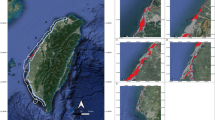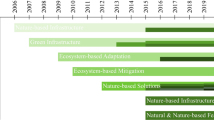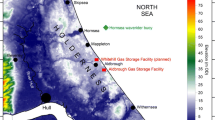Abstract
Chennai Port (13.099872° N, 80.297407° E), located along the southeast coast of India, has been a hub for maritime trade since the fifteenth century. An artificial harbour was initially constructed in 1881 which underwent numerous expansions in the following years. The breakwaters of the harbour intercepted the heavy sediment-laden littoral drift along the coast, resulting in the formation of the world’s second-longest urban beach south of the port, i.e. on its up-drift side. Meanwhile, the coast north of the port, i.e. the down-drift side, experienced intense erosion due to a lack of sediment supply and forces induced on the coast due to waves and currents. The shoreline change study in this paper investigates a shoreline stretch of about 6 km (protected by transitional groynes), north of Chennai Port by dividing it into three segments. The rate of shoreline changes over a period of about 12 years across three different segments was assessed using statistical parameters by employing remote sensing techniques complemented with geographical information system (GIS) and digital shoreline analysis system (DSAS) tool. It is inferred that the coast has witnessed accretion and sizable growth in beach width has been observed post the construction of groyne field.


source: Natesan & Subramanian, 1994)

source: Sundar & Sannasiraj, 2014)









Similar content being viewed by others
Availability of data and material
The data used for the study are Open Source Satellite imagery data, which was processed with an academic licence for ArcGIS software application.
Code availability
The authors did not write any exclusive code to project the results in this paper.
References
Addo, A. K., Jayson-Quashigah, P. N., & Kufogbe, K. S. (2011). Quantitative analysis of shoreline change using medium resolution satellite imagery in Keta, Ghana. Marine Sciences, 1, 1–9. https://doi.org/10.5923/j.ms
Bayram, B., Acar, U., Seker, D., & Ari, A. (2008). A novel algorithm for coastline fitting through a case study over the Bosphorus. Journal of Coastal Research, 24(4), 983–991.
Chand, P., & Acharya, P. (2010). Shoreline change and sea level rise along coast of Bhitarkanika wildlife sanctuary, Orissa: An analytical approach of remote sensing and statistical techniques. International Journal of Geomatics and Geosciences., 28, 436–455.
Chang, R. F. (1997). Coastal engineering environment. Qingdao Ocean University Press.
Cracknell, A. P. (1999). Remote sensing techniques in estuaries and coastal zones—An update. International Journal of Remote Sensing, 20, 485–496.
Dolan, R., Fenster, M. S., & Holme, S. J. (1991). Temporal analysis of shoreline recession and accretion. Journal of Coastal Research, 7(3), 723–744.
Ekercin, S. (2007). Coastline change assessment at the Aegean Sea coasts in Turkey using multitemporal Landsat imagery. Journal of Coastal Research, 23(3), 691–698.
El M’rini, A., Maanan, M., Anthony, E., & Taaouati, M. (2012). An integrated approach to characterize the interaction between coastal morphodynamics, geomorphological setting and human interventions on the Mediterranean beaches of North-Western Morocco. Applied Geography. https://doi.org/10.1016/j.apgeog.2012.08.009
Frihy, O. E., Dewindar, K. M., & Banna, L. M. (1998). Natural and human impact on the northeastern Nile delta coast of Egypt. Journal of Coastal Research, 14, 1109–1118.
Hsu, T., Ou, S., & Tzang, S. (2000). Evaluations on coastal topographical changes at Hualien Coast. Taiwan. Journal of Coastal Research, 16, 790–799.
Kabuth, A. K., Kroon, A., & Pedersen, J. B. T. (2013). Multi-decadal shoreline changes in Denmark. Journal of Coastal Research, 30(4), 714–728. https://doi.org/10.2112/JCOASTRES-D-13-00139.1
Kana, T. W. (2003). Coastal erosion and solutions: A primer. Coastal Science and Engineering LLC, Columbia, pp. 25.
Kermani, S., Boutiba, M., Guendouz, M., Guettouche, M. S., & Khelfani, D. (2016). Ocean & coastal management detection and analysis of shoreline changes using geospatial tools and automatic computation: Case of Jijelian sandy coast (East Algeria). Ocean and Coastal Management, 132, 46–58. https://doi.org/10.1016/j.ocecoaman.2016.08.010
Komar, P. D. (1998). Beach processes and sedimentation. Prentice-Hall Inc.
Wu, W. (2007). Coastline evolution monitoring and estimation—A case study in the region of Nouakchott. Mauritania, International Journal of Remote Sensing, 28(24), 5461–5484.
Kuleli, T. (2005). Change detection and assessment using multi temporal satellite image for North-East Mediterranean Coast. GIS Development Weekly, 1(5).
Kumaravel, S., Ramkumar, T., Gurunanam, B., Suresh, M., & Dharanirajan, K. (2013). An application of remote sensing and GIS based shoreline change studies – A case study in the Cuddalore District, east coast of Tamilnadu, South India. International Journal of Innovative Technology and Exploring Engineering, 2(4), 211–215.
Mahapatra, M., Ramakrishnan, R., & Rajawat, A. S. (2014). Shoreline change analysis along the coast of South Gujarat, India, using digital shoreline analysis system. Journal of the Indian Society of Remote Sensing, 42(4), 869–876.
Maia, L. P., Jimenez, J. A., Serra, J., Morais, J., & Sa´ Nchez-Arcilla, A. (1998). The Fortaleza (NE Brazil) Waterfront: Port versus coastal management. Journal of Coastal Research, 14, 1284–1292.
Mani Murali, R., Dhiman, R., Choudhary, R., Seelam, J., Ilangovan, D., & Vethamony, P. (2015). Decadal shoreline assessment using remote sensing along the central Odisha coast. India. Environmental Earth Sciences, 74(10), 7201–7213. https://doi.org/10.1007/s12665-015-4698-7
Masria, A., Nadaoka, K., Negm, A., & Iskander, M. (2015). Detection of shoreline and land cover changes around Rosetta Promontory, Egypt, based on remote sensing analysis. Land, 4, 216–230. https://doi.org/10.3390/land4010216.
Nandi, S., Ghosh, M., Kundu, A., Dutta, D., & Baksi, M. (2016). Shoreline shifting and its prediction using remote sensing and GIS techniques: A case study of Sagar Island, West Bengal (India). Journal of Coastal Conservation, 20, 61–80. https://doi.org/10.1007/s11852-015-0418-4
Natesan, U., & Subramanian, S. P. (1994). Identification of erosion-accretion regimes along the Tamilnadu coast. India. Journal of Coastal Research, 10(1), 203–205.
Natesan, U., Anitha, P., Vishnunath, R., Edwin, G., & Ferrer, V. (2015). Monitoring long-term shoreline changes along Tamil Nadu. India Using Geospatial Techniques. Aquatic Procedia., 4(10), 1016.
Quattrochi, D. A., & Goodchild, M. F. (1997). Scale in remote sensing and GIS. Lewis Publishers.
Raffy, M. (1994). Change of scale theory: A capital challenge for space observation of Earth. International Journal of Remote Sensing, 15, 2353–2357.
Shaghude, Y. W., Wannäs, K. O., & Lundén, B. (2003). Assessment of shoreline changes in the western side of Zanzibar channel using satellite remote sensing. International Journal of Remote Sensing, 24(23), 4953–4967.
Stokkom, H., Stokman, G., & Hovenier, J. (1993). Quantitative use of passive optical remote sensing over coastal and inland water bodies. International Journal of Remote Sensing, 14, 541–563.
Sundar, V., Sannasiaj, S. A., & Anand, K. V. (2014). Sediment transport in the vicinity of erosion-prone coast of North Chennai. Proceedings of Indo-Japan Workshop on River Mouths, Tidal Flats and Lagoons, IIT Madras, Chennai, India, Sep., 15–16, 252–262.
Sundar, V., & Sannasiaj, S. A. (2014). Risk assessment and disaster management plan for North Chennai. Report submitted to the Public Works Department, Tamilnadu, India.
Thieler, E. R. (2005). Digital shoreline analysis system—User’s guide, version 3.0. U.S. Geological Survey open-file report no. 2005, 1304, 1–28.
Vanderstraete, T., Goossens, R., & Ghabour, T. K. (2006). The use of multi-temporal Landsat images for the change detection of the coastal zone near Hurghada. Egypt. International Journal of Remote Sensing, 27(17), 3645–3655.
Welch, R., Remillard, M., & Alberts, J. (1992). Integration of GPS, remote sensing, and GIS techniques for coastal resource management. Journal of Photogrammetric Engineering and Remote Sensing, 58, 1571–1578.
Funding
The authors hereby acknowledge the financial support provided by the Department of Science and Technology, Govt. of India through Grant No. DST/CCP/CoE/141/2018C under SPLICE—Climate Change Program.
Author information
Authors and Affiliations
Corresponding author
Ethics declarations
Ethics approval
This manuscript was drafted by following all ethical guidelines laid down by the journal.
Consent to participate
All the authors of this paper has given consent for the manuscript to be submitted to the “Environmental Monitoring and Assessment” journal.
Consent for publication
All the authors of this paper has given consent for the manuscript to be published in the “Environmental Monitoring and Assessment” journal.
Conflict of interest
The authors declare no competing interests.
Additional information
Publisher's Note
Springer Nature remains neutral with regard to jurisdictional claims in published maps and institutional affiliations.
Rights and permissions
About this article
Cite this article
Sundar, V., Sannasiraj, S.A., Ramesh Babu, S. et al. Shoreline changes due to construction of groyne field in north of Chennai Port, India. Environ Monit Assess 193, 830 (2021). https://doi.org/10.1007/s10661-021-09590-1
Received:
Accepted:
Published:
DOI: https://doi.org/10.1007/s10661-021-09590-1




